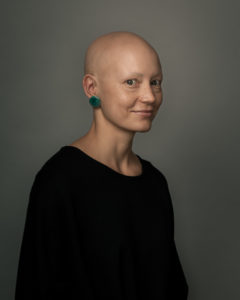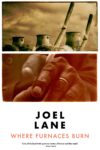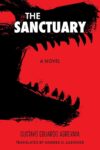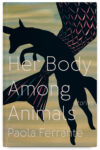
Photo credit David Barry
The uncanny worlds of Helen Phillips—with their doppelgangers, Kafkaesque workplaces, and anxiety—are as dark as they are inviting. With real linguistic care and an increasing flair for plot-driven stories since her experimental debut, Phillips coaxes her readers into her gingerbread house in the woods, and forces confrontations with the absurd and the monstrous and the strange. If the reader is very lucky, she might then make the reader tea. Having been Phillips’s pupil and currently being neighbors, she invited me to her home and we had tea while we talked about her career, a conversation that started with us sitting in the bright light of the afternoon talking about her first book, the experimental And Yet They Were Happy (Leapfrog 2011) and ended with us talking about her latest book, The Need (Simon & Schuster 2019) while walking in the dusk of early evening to meet her children getting off the bus.
A fair spoiler warning, though: her novels, described lovingly as “existential thrillers,” are best experienced without knowing what’s coming, and we do discuss the ending of The Need.
Kyle Williams: I would be really interested in trying to talk from your first book, And Yet They Were Happy, to your latest, The Need. The former was published by a relatively obscure small press, and the latter is your fourth major press publication. They feel like very aesthetically different places. How do you think about your first book, now? Do you?
Helen Phillips: I do think about it. Actually, a story from And Yet They Were Happy was just republished under an Artists’ Project for Greenpeace curated by Lauren Groff.
When I wrote And Yet They Were Happy, I learned a way of writing that has stayed with me, that is really foundational to everything I’ve done since. It was a project of condensing a narrative or an image down to the essential components, and just having the bone, or the muscle—just the thing itself. All the stories are 340 words, and so I would overwrite and then spend most of my time condensing. That’s true of The Beautiful Bureaucrat too—it was very long, and then I cut it in half. With The Need, it’s still the same process. My second draft is always slimmer than my first. And Yet They Were Happy was an exercise in crystallizing language. The lessons I learned from that stay with me.
I also feel that there were certain elements of my writing that I was practicing in And Yet They Were Happy that had to do with language: the way language sounds, evoking an image. Concerns that are more perhaps connected to poetry—though I would never call myself a poet. After I wrote And Yet They Were Happy, I felt I wanted to challenge myself to write a more sustained narrative: Could I combine those elements of language with a plot that moved in a forward direction? Because sometimes it seemed to me that it was hard to, that the pleasure of those elements didn’t work well with a forward-moving plot. After And Yet They Were Happy, I went in such a different direction by writing a book for children. Here Where the Sunbeams Are Green, the second book, was everything that the first book wasn’t, and I wanted to do it for kids because I wasn’t sure I wanted to write a sustained narrative for an adult audience.
I love the movement from this highly experimental story collection . . . novel . . . collection of prose poetry . . .
Whatever it is.
To middle grade chapter book.
I had a lot of fun flexing my muscles in that direction. I also wanted to prove to myself that could do it.
Then I wondered, Can I do both? Can I have the abstraction, the (hopefully) existential questions, and a plot with forward momentum, with the joy of forward momentum? I went through a period in grad school where I was very scornful of plot overall, which I know you also feel, and the reason we feel that way is because there are so many amazing things a narrative can deliver aside from plot. And sometimes plot might distract or take energy away from those things. So I understand why I felt that way, but eventually I saw plot’s possibilities, that plot could be wild or defiant in its own way.
I was talking to a friend of mine who was studying theoretical architecture, and she too had gone through this period of being scornful of real buildings.
I actually had this same conversation recently, where an architect had become scornful of the idea of a building that could actually stand.
Right, maybe there is something to be said for buildings that can stand, maybe there is something to be said for books that have plots.
So in The Beautiful Bureaucrat I was trying to unite what I had practiced in And Yet They Were Happy and Here Where the Sunbeams Are Green. It took me eight years to figure out how to do it, but by the end I was satisfied with that, and felt I had done the two different things I wanted to do.
I loved the coverage it got when it came out calling it an existential thriller.
That was awesome. As I was writing I had that phrase in my head, but for other people to notice it too, and for it not to be just some fantasy I had . . .
So The Need was born out of that, continuing those questions: Could you have the attention to language and abstraction and metaphor and existential questions—and have a plot that propelled the reader forward? An example of a book that has done that for me is Fever Dream by Samantha Schweblin, which I recommend more than I recommend anything else
You have recommended that book to me, even after I’d told you I read it.
I recommend that book nonstop. You should probably just read it again.
But there is something to be said for when you offer the reader that kind of momentum—it enables you to take them places that you might not otherwise be able to. This is what I was thinking about when I was writing those early chapters of The Need, but I also thought about the way I read when I was a child. In a way, when I was a child, I was the best reader I’ve ever been. I would, without guilt or thinking about my to-do list, sink into a book like a rock and just be there. And it’s so hard for me to do that now.
It might be more difficult for anybody to do that now, with the news, and social media.
That’s a good point, there might be this general feeling of distraction. But this feeling of being able to sink into a book so deeply, and the joy of reading a book that has a cliffhanger at the end of every chapter—it sounds like a cheap trick, but it’s really an awesome trick at the same time. It was fun writing the early chapters of The Need to have that swiftness.
The opening of that book really is cliffhanger after cliffhanger.
Right, for the beginning I really wanted that momentum. And as someone who, at one point, was not very interested in plot, this was a really new thing to take on, to have this thriller-like momentum. I mean, I don’t know if it reads like a thriller, people have called it all sorts of things. Much to my surprise, people have called it a horror novel.
I could see it.
I could see it. I never thought of it being a horror novel when I was writing it, so when that became a relatively common way to describe it, I was really shocked. Maybe also because “horror” sounds so bloody, in a way that the book is not. And also because I can’t even watch horror movies. I’m such a wimp about this kind of thing, so it was interesting to have my work described that way.
I’ve called it a maternal thriller.
Someone else has called it a lactation thriller. I like “existential lactation thriller.”
I’d love to talk a little bit about the really visceral maternal anxiety throughout The Need. When you were writing, trying to balance language with plot, how did you arrive at the lactation horror?
It was more the reverse. It’s more that I wanted to try to find a way to write about motherhood, and that led me to the idea of a thriller. Which I know sounds kind of strange, because you think of motherhood as being home-bound, that your life doesn’t have as much drama as it once did.
Those people have never watched Aliens.
True. So when I was thinking of what it can feel like to have this responsibility to these vulnerable people who you love above all else, and to have another set of responsibilities to a professional identity, and to be sleep-deprived so that you’re in a kind of half-dream state all the time, and to have looming doubts about your own capacity to protect your children and raise them in a world where there’s climate change and disturbing political situations—all of it adds up to this rich, dark, terrifying, joy-infused waking dream. And there are times when you almost feel like a heroine in a thriller when you’re getting your kids ready for their day and then you’re running off to work and being very engaged in your workday and then you’re running home and you’re getting the kids ready and you’re trying to do some of your own creative project—you feel like you’re the protagonist in some kind of dramatic tale.
Those conflicting sets of responsibilities that one feels when one is a mother really becomes the metaphor of The Need, with the doppelganger. Was it almost like wish-fulfillment, to think there could be two of you?
Yeah! A very common thing to wish is, “If only I could clone myself, then all my problems would be solved.” I’ve heard many parents say that, it’s a cliché. And I’m often interested in a cliché that, if you actually look at it, what would it be like? What if you actually had a doppelganger who wanted to do the things you do, how would that displace you from your life? How would you feel, being displaced from your life? If you actually follow through on that “What If?”
I love that what you’re saying turns the doppelganger into an almost positive force in the world, when the doppelganger is a horror trope with all these dark connotations, which play out in The Need really well.
I feel like the doppelganger is scary because it’s the ultimate threat to your identity. But your doppelganger could also be your greatest ally. And this is not the only time I’ve written about doppelgangers; there’s a story in Some Possible Solutions called “The Doppelgangers.
You have that wonderful New York Times piece, which I think about all the time.
Oh yeah, that’s true, as a bald woman I have bald women doppelgangers. And even in The Beautiful Bureaucrat, the protagonist sometimes sees women who look like her walking around. In And Yet They Were Happy there are “the Helens.”
Why do you keep returning to doppelgangers?
I hope it’s not narcissism. I think the doppelganger is an attempt to view yourself from the outside. If you can view yourself from the outside, and feel empathy toward yourself, there is a natural extension to feel empathy for others.
That’s such a positive view. You don’t watch horror movies, so you haven’t seen Us.
I couldn’t even make it through the preview, I was so scared. I feel that I should watch it, but the images of horrific things haunt me forever, and I probably already have enough dark content in my mind without the assistance of Hollywood.
But with that movie, this book, and a variety of other media—it seems like the doppelganger is having an interesting cultural moment.
I agree. I don’t know why. For me, it’s a way of moving from the self, trying to understand yourself as separate from you, and then using that to extend understanding to other people.
In The Need, the doppelganger starts, as you say, as a horrifying thing. What could be scarier than an intruder in your home who also seems to be fairly well acquainted with your home? I wanted that figure to be as threatening as possible. But the journey of the book is toward understanding that that figure, who is “the Other,” goes from the role of nemesis to something very different. All the assumptions you would have about an intruder in your home—what they want from you—end up being challenged by the end of the book. To me, a lot of the book is about empathy.
That’s really eye-opening to me, especially because I felt like I didn’t much know what to do with the novel’s ending. The momentum of the novel challenges the reader’s expectations so many times that I felt like I was expecting so many different possible outcomes, none of which ended up happening.
I tend not to talk about the ending. But I will say that, with the momentum that carries you to the end, I wanted to give the reader an ending where you pick your own adventure. I rewrote the ending countless times in order to get this. I want you to decide: Does Moll vanquish Molly, or does Molly overcome Moll? I worked so hard to make the reader ask, Who is the woman in the final scene? I wanted it to be a mirror to the reader, so that where your mind goes with what happens at the end, maybe reveals something to you about yourself.
When I hold the mirror up to myself, to me, they join into one. Joined together, they are as powerful as they wanted to be. But people have told me so many different things about the ending. It’s fun for me to have so many different reads of it. It’s an unclear ending but if it’s clear to you, you made some kind of a choice. I find that very exciting.
Early on, my wonderful sister read an early draft of the book, and she articulated what I was trying to do with the ending really well. She said, I think the final ending you’re trying to write could either be read as incredibly beautiful and empowering or as the most terrifying scene in the book. I thought she put it well.
For me, it’s a happy ending. But I also really worked to make room for other understandings.
I’ve always been really interested in what is at this point your well-documented imagistic approach to writing. Your novels start as this list of images that you find a way of connecting to a narrative. How did you arrive at that process? What propels you to write toward image?
Writing toward image has always been the only way I’ve understood how to write. I can’t even conceive of another starting place. I was on a panel once and someone asked us, Where do you begin? One person said plot, one said character, and I said image. Karen Russell says setting.
But in terms of keeping the long list of images for years before I start writing, I arrived at that for practical reasons. Keeping a running list was a way of dealing with the constraints of my life making it so I couldn’t give a project any attention. Now I love those years of just throwing images into a file—and a ton of newspaper headlines, for my new book, because they’re so surreal—I love that gestation period. It’s crucial.
I think you are the only person I have ever heard give a real answer to the impossible question, What is your process?
The part that is hard is building something from that document. That’s when my head hurts for months on end—that’s where I am right now, and that part of the process is much more difficult to articulate. But at least I have this incredible scaffolding that I’ve been building for a long time. Again I’m going to quote my wonderful sister, but the collecting of the material is like building the mountain and the writing of the book is like climbing the mountain.
As a writer compelled toward images, what do you think image does?
A lot of what I turn to literature for is an embodiment of emotions and ideas that defy language. An image can help you arrive at things that are hard to articulate. Evoking an image makes something concrete.
In my new book I’m writing a lot about climate change, but I don’t think I’ll ever use the term. I want it to be embodied. I think a really clear, concrete image well evoked does a certain kind of emotional or intellectual work: to me, a series of connected images does better than trying to express something head-on. Images can serve this elliptical purpose that spiral you closer to something.
I’ve always been mystified by this draft-zero document of yours. I’m thinking about this line in The Need that feels like a hint toward this document, “Lined up on a windowsill: a Coca-Cola bottle, an Altoids tin, a toy soldier, a potshard, a penny.”
That’s a good example. Something I would write in my ongoing list is, like, “Picture a Coca-cola bottle with the font tilting the wrong direction.” I like mundane objects that are beautiful, but you never notice they are beautiful because they’re mundane. Pennies are the same way. At the beginning of The Need, Molly has to compare these two pennies side-by-side. What could be a more mundane object? But another example of something I would write in that document is, “What would it be like to compare two pennies and try to find the differences between them?”
Kafka is on the shelf behind you.
He usually is.
That sounds like a job a Kafka office worker would receive: Find the differences between these two pennies.
I maintain my fascination with bureaucracy. It’s so funny that when you marry someone, you file paperwork in a bureaucratic office. You’re doing this thing of the heart, of the body, and then there’s the paperwork.
You’ve talked about Kafka as an influence before. The Beautiful Bureaucrat has Kafka’s influence on the surface, and something I’m thinking about a lot because I’m rereading Kafka is how profoundly anti-capitalist he is. His absurdity is not the same as Camus’s or Kierkegaard’s “benign indifference of the universe.” It’s much more localized to the cruel indifference of institution, in a way The Beautiful Bureaucrat captures really well. If the locus of environmental challenge in The Beautiful Bureaucrat is institutional, and the environmental challenge of And Yet They Were Happy is an apocalyptic environment, I’m trying to find that locus in The Need. Maybe it’s the doppelgangers?
The enemy in The Need is your own dread, in a way, and the potential bad things that can happen to you and the ones you love. It’s not something without but something within. I mean, I have a lot to say about Kafka. The Need, on the surface, doesn’t feel nearly as connected to Kafka as The Beautiful Bureaucrat. But one thing that I love about Kafka, on a mechanical level, is how his characters just exist in their situation without exposition—I find that very liberating as an author. It’s annoying to me to feel the pressure of having to explain a character by way of their childhood. Some books do that beautifully, but I want my work to be about who characters are in this present moment. There’s this pressure in fiction to tell everything about a character, and I think Kafka gave me the permission to just say that we are with this person, at this moment, and this is what matters. There’s an intensity, starkness, and rawness to that, that has always really struck me. I like being able to just throw a character in a situation like that: a sort of the existential hero who only has their presence and their confrontation with the void.
There was a recent review of The Need that talked about what a lonely evocation of motherhood it is—that Molly seems so lonely and distant, she has no cohort, she isn’t on mommy blogs, etc. I mean, sure. But that’s not what I’m interested in. I’m interested in a character who confronts the void alone. No one is asking, “Why didn’t the hunger artist have a family to support him?” But when you’re writing about motherhood people are more upset that this person, for a few days of her life, is alone with the void. But I wanted to put her in a stark situation, which is what Kafka does.
I’m interested in those moments when, in the dead of the night, you wake up and your child says, “I’m scared of death,” and it’s just you and your child. There are moments when you’re intensely alone.
Kyle Williams is a writer living in Brooklyn. He is an Interviews Editor for Full Stop, Director of Communications for Chicago Review of Books, and A Public Space’s 2019 Emerging Writer Fellow. He is on Twitter @kylecangogh.
This post may contain affiliate links.







